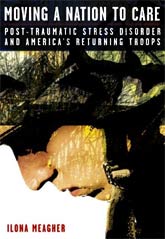LinkBlog
Cannabis, the mind and society: the hash realities (PDF - free reg. req'd)
The Role of Cognitive and Behavioral Therapies in the Treatment of Insomnia
Have you outsourced your brain?
Study finds potential PTSD biomarker
New research identifies a characteristic physiological response in veterans with post-traumatic stress disorder (PTSD) that could be used as a biomarker to diagnose the disease.
"PTSD can be a debilitating disorder that creates cognitive disability as well as internal stress for the victim and produces stress for family and friends. And it is an increasing public health concern," says Bruce McEwen, PhD, of Rockefeller University in New York City. "Understanding what goes on in the brain is critical to finding successful treatments, including pharmaceutical therapies and cognitive behavioral therapies that enhance extinction of the fear-related memories."
PTSD is the most common mental health disorder among veterans of the conflicts in Afghanistan and Iraq. As the profile of PTSD rises, new findings are increasing researchers' understanding of the way memory malfunctions in PTSD, creating characteristic symptoms such as flashbacks and fear reactions to trigger sounds, even in safe situations.
Research with veterans from the Serbo-Croatian War of the early 1990s confirms previous research showing that veterans with PTSD react in fear even when shown signals they have come to associate with safety. It also has led to the identification of the first biomarker for PTSD, which may become useful in testing the value of treatments for the disorder.
"One of the central features of the disorder is the inability of the brain to distinguish between dangerous and safe situations," says Michael Davis, PhD, of Emory University School of Medicine. "For example, a woman who was raped by a stranger may later not even feel safe with her husband. That is, she has lost the ability to distinguish between dangerous and safe situations."
Working with 33 veterans, Davis measured the degree to which subjects were startled, as well as their ability to overcome this fear response, as he evoked certain conditioned responses.
The study used yellow, green, and blue lights, which, in pairs, signaled caution or safety. Davis first trained the subjects to associate the yellow and green lights with a blast of air to the throat. How hard the veterans blinked was recorded as a measure of their startle response to this combination of colored lights. The study then created an association between a blue-green pairing of lights and no air blast, establishing a signal for relative safety.
To measure how safe the blue light made the subjects feel, Davis then recorded responses to a blue-yellow signal. What he found was that although healthy subjects startled less when they saw the blue and yellow lights than when they saw the green-yellow combination, those with PTSD could not suppress their fear response. This indicated an inability to respond to indicators of safety.
"This test can provide a more objective way of measuring fear control mechanisms that work in healthy people and do not work in patients with PTSD," says Davis. "In fact, this finding may provide one of the first biomarkers for PTSD, namely an objective physiological measure of abnormal fear regulation. It may also become a valuable clinical tool to assess and compare the effectiveness of different treatments in different populations of PTSD patients, such as civilians and combat veterans."
Jovanovic T, Norrholm SD, Jambrosic-Sakoman A, et al. Conditioned and external fear inhibition in combat- related PTSD in Croatian war veterans. Session 639.6/FFF22, 2007 Neuroscience - San Diego CA, 2007 Nov 6. [Abstract]
















